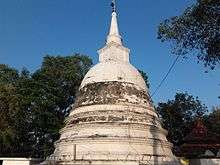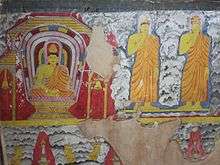Asgiriya Raja Maha Vihara, Gampaha
| Asgiriya Raja Maha Vihara අස්ගිරිය රජ මහා විහාරය | |
|---|---|
 | |
| Basic information | |
| Location | Asgiriya, Gampaha, Sri Lanka |
| Geographic coordinates | 07°06′39.6″N 79°59′22.7″E / 7.111000°N 79.989639°ECoordinates: 07°06′39.6″N 79°59′22.7″E / 7.111000°N 79.989639°E |
| Affiliation | Buddhism |
| District | Gampaha |
| Province | Western Province |
| Heritage designation | Archaeological protected monument[1] (22 November 2002) |
| Architectural description | |
| Architectural type | Buddhist Temple |
| Architectural style | Cave temple |
Asgiriya Raja Maha Vihara (Sinhalese: අස්ගිරිය රජ මහා විහාරය) is an ancient Cave temple situated in Gampaha District, Sri Lanka. The temple is located on top of a hillock on the Gampaha - Minuwangoda Road and approximately 2 km (1.2 mi) away from Gampaha city. Currently this temple has been declared as archaeological protected site in Gampaha District by Archaeological department.
Name
It is said that the name of Asgiri was formed after the lost of horse of Prince Uttiya, the brother of King Kelanitissa, in this area.[2]
History

It is believed that the history of this temple goes to the reign of King Valagamba (89-77 BC). According to the legends King Valagamba, who fled from Anuradhapura after invasions from South India in 104 BC, stayed in this historical places from time to time.[2][3] During the reign of King Parakramabahu VI this Asgiriya Rajamaha Vihara had received the patronage by provincial King Sakala Kala Vallaba.[4]
Structures
This cave temple with drip ledges has been constructed with wattle and daub. To the right of the cave temple a Devalaya can be seen. The image house of the cave temple has been built little high from floor ground. A wooden flight of stairs had been made for enter it. Inside the image house there is a Samadhi Buddha statue with features of art in the Kandyan period. On the either side, images of Buddha in Abaya mudra can be seen. The canopy of the cave is decorated with lotus flowers and with various other flower designs.[4]
In the upper ground surface of the rock a Sannasa (Deed of grant) with the picture of a horse is found. Also there is a pond made on the rock and the Stupa is situated adjacent to it. In the top portion of the rock surface there is a stone with foot print of Buddha. On the other side of the rock surface, a big cave with drip ledges can be seen.
See also
References
- ↑ "Protercted Monument List 2012-12-12" (PDF). Department of Archaeology. 12 December 2012. Retrieved 27 March 2016.
- 1 2 "Gampaha Asgiriya Raja Maha Viharaya – ගම්පහ අස්ගිරිය රජමහා විහාරය". Amazinglanka. Retrieved 22 February 2016.
- ↑ "ගම්පහ අස්ගිරිය රජ මහා විහාරයේ පැරැණි බුදු මැදුර (in Sinhala)". Budud Sarana. 13 August 2009. Retrieved 22 February 2016.
- 1 2 "A Sanctuary where Myth And Fact Combine". Exploresrilanka. April 2011. Retrieved 22 February 2016.